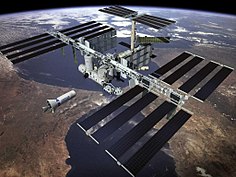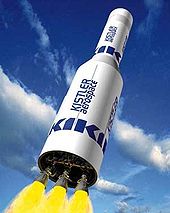Kistler K-1

The Kistler K-1 rocket was a completely reusable launch vehicle under development from the 1990s to 2007 . The development began at the US American Kistler Aerospace Corporation, which continues the development under the new company name Rocketplane Kistler after a business combination with Rocketplane Limited Incorporated . The K-1 concept became known from participation in the Commercial Orbital Transportation Services program advertised by NASA to supply the International Space Station . The payload capacity of the K-1 should be 4,600 kg for a 200 km high orbit .
Technology and structure
The Kistler K-1 was a two-stage rocket and consists of a Launch Assist Platform , which is the first stage, and the Orbital Vehicle , which carries the payload at the top. The total height of the rocket was 36.9 meters with a takeoff weight of around 383.3 tons. Both stages of the innovative concept should be able to land undamaged after successful use with the help of parachutes and airbags. By reusing the assemblies, Rocketplane Kistler hoped to create a significantly more cost-effective launch system compared to the established disposable rockets. In addition to the transportation of smaller satellites , the provision of the orbiting vehicle as a platform for automatic experiments in weightlessness was the main area of application for the K-1. As part of the COTS program tendered by NASA, a version with a freight module was also created, which was supposed to transport around 2.7 tons of freight to the ISS. For docking with the ISS, it was planned to capture the orbiting vehicle with the aid of the station's own robotic arm and dock it to a Common Berthing Mechanism on the American part of the station.
The engines of the commercially available Soviet type Kuznetsov NK-33 and Kuznetsov NK-43 , modified by the American company Aerojet , were selected as propulsion for the rocket . Both engines were originally developed for the Soviet N1 moon rocket and are to be used modified as AJ26-58 and -59 for the first stage and as AJ26-60 for the second stage. Initially, Woomera in Australia was planned as the primary launch site , later launching from other locations such as the Nevada Test Site was also considered.
Stage of development
As a privately financed company, Kistler has had financial problems time and again since the start of development. Serious setbacks were the bankruptcies of Iridium Incorporated in 2000 and Globalstar in 2002, which, as operators of the satellite telecommunications systems of the same name, had expressed interest in the K-1 as a launch vehicle. The first launch of the K-1 has been postponed again and again since 2000. After the company merger with Rocketplane Limited Incorporated, further financial problems meant that in September 2006, only one month after the start of participation in the COTS program, the first appointments with NASA could not be kept, although large parts of the first prototype were already in place were made. A revised COTS contract presented in February 2007, according to which private investors were to provide 500 million US dollars in addition to NASA funds, did not lead to success, so that NASA excluded Rocketplane Kistler in October 2007 announced to the COTS program. After the originally agreed grant of US $ 207 million was discontinued, Kistler was forced to lay off employees and cancel orders from suppliers. The development of the K-1 had not made any significant progress since then; a test flight could no longer be carried out. In June 2010, Rocketplane finally filed for bankruptcy.
High cash prizes and lucrative transport contracts were promised for the privately organized development of spacecraft. After the insolvency of the original favorite Rocketplane Kistler and the associated failure of the Kistler K-1 supply system, NASA selected the Orbital Sciences Corporation (OSC) Cygnus project as a replacement in February 2008 .
Technical specifications
| step | Engines | fuel | diameter | length |
|---|---|---|---|---|
| 1st stage (LAP) | 2 AJ26-58, 1 AJ26-59 | Kerosene / liquid oxygen | 6.70 m | 18.30 m |
| 2nd stage (OV) | 1 AJ26-60 2 auxiliary power units |
Kerosene / Liquid Oxygen Ethanol / Liquid Oxygen |
4.27 m | 18.60 m |
swell
- ^ International Space Station Resupply. Rocketplane Kistler, archived from the original on November 21, 2013 ; accessed on August 12, 2009 .
- ^ Andy Pasztor: Rocketplane Cuts Workforce As Financial Woes Mount. Wall Street Journal, August 23, 2007; accessed August 12, 2009 .
- ^ Jeff Foust: The gap in NewSpace business plans. The Space Review, July 12, 2010, accessed August 4, 2010 .
Web links
- Official website of Rocketplane Kistler. Archived from the original on November 26, 2013 ; accessed on August 12, 2009 .
- Rocketplane Kistler and COTS in Raumfahrer.net (2006)
- Bernd Leitenberger: The Kistler K-1 launcher
- Kistler K-1 in the Encyclopedia Astronautica (English)


